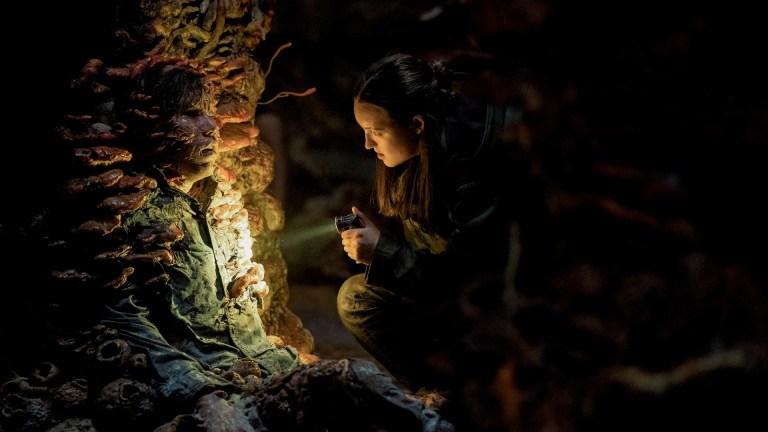The Last of Us Season 2 Finally Introduces a Key Mechanic From the Game
Fungal spores are a common way for Cordyceps to spread in The Last of Us games, but haven't appeared in the series until now

This article contains spoilers for The Last of Us season 2 episode 5.
In the first season of HBO’s The Last of Us, series creators Craig Mazin and Neil Druckmann decided to forgo an element of the Cordyceps infection from the game. Instead of using airborne spores as a vector for the Cordyceps fungus to spread, they developed a network of tendrils that gives the Cordyceps a sort of hive-mind capability. If you brush up against a tendril in one location, it can alert infected miles away of your presence. But now that Cordyceps seems to be evolving once again, the show has finally brought back this key mechanic from the game for season 2.
In The Last of Us Part I and Part II, there are several levels where characters have to don face masks to enter an area because it is so saturated with Cordyceps spores that they’ll become infected if they breathe them in. In fact, one of the very first encounters in The Last of Us Part I involves Joel and Tess coming across a man whose mask has been compromised. The spores are so deadly that this man begs Joel to shoot him rather than let him succumb to the fungus.
Even though this mechanic plays an important part in gameplay, it makes sense that Druckmann and Mazin wouldn’t want it to bring it into the series in the exact same way. When asked about the decision to take away spores last season, Druckmann told Polygon that they wanted to treat the Cordyceps infection more “realistically.” If characters encountered spores and had to wear gas masks all the time “we lose so much, which is maybe the most important part of the journey is what’s going on inside behind their eyes, in their soul, in their beings. For that logistical reason, we were like,’ Let’s find a different vector.’”
And that vector has certainly worked in upping the scare factor of those infected by Cordyceps. The tendril network has triggered more than a few terrifying encounters across both seasons thus far from the Boston horde that killed Tess to the attack on Jackson. But now it seems like Cordyceps is evolving in even more terrifying ways.
While promoting season 2 at SXSW 2025, Druckmann confirmed that there would be “an escalation of numbers and types of infected, but also, as you see in the trailer, an escalation of the vector of how this thing spreads.” Mazin chimed in soon after confirming that “spores are back” this season. Druckmann then went on to explain “The reason [we’re doing it now], I mean, we really wanted to figure it out, and again, everything has to be drama. There had to be a dramatic reason of introducing it now. And there is.”
So far this season, they’ve already introduced a new type of infected from the games – stalkers. We saw Ellie (Bella Ramsey) face off against one in an abandoned grocery store in Jackson, and now Ellie and Dina (Isabela Merced) almost succumbed to a group of them in Seattle. But that’s not the scariest part of episode 5.
Episode 5 begins with a conversation between W.L.F. officers Hanrahan (Alanna Ubach) and Park talking about an incident that occurred while clearing out infected from the hospital that the W.L.F. is trying to use as a base. In the basement levels, a squad of soldiers began to report back that there weren’t any infected to fight, but that they were having trouble breathing. One of the soldiers, Sergeant Park’s son, Leon, told her to seal them in and block off access to the area the best they could. The situation has clearly left both of these soldiers shaken about what could be lurking in the depths of the hospital.
Later on in the episode, Ellie inadvertently chases Nora (Tati Gabrielle) into the basement levels where we finally get to see for ourselves what the soldiers were so terrified of. The Cordyceps has grown into the walls, as we’ve seen before, but this time it’s done something different to its hosts. Instead of transforming these people into bloodthirsty drones, the Cordyceps has taken them into the walls, keeping them ‘alive’ just enough to use their respiratory system as a vector for spores.
As Ellie walks through, we see Leon among the bodies exhaling spores into the air. Even though he hasn’t been down there for long, he already has a lot more fungal growths over his body than early-stage infected (runners) typically do. Thankfully, Ellie’s immunity carries over into this new delivery method, but Nora is not so lucky. It doesn’t take long for her to start coughing and twitching as the Cordyceps takes over.
This is a pretty smart way to introduce spores into The Last of Us without changing the rules of Cordyceps laid out in the show. We’ve seen the infected evolving already, so it makes sense that spores could be a logical next-step in evolution for the fungus. Especially in a place like Seattle with a climate that is conducive to fungal growth. This hospital was also ground-zero for the Cordyceps outbreak in Seattle, so the fungus here has had quite a bit of time to mature and develop new ways to spread while the humans outside wage their wars with each other.
Spores in this version of the story are even more terrifying, in a way. In the game, characters are used to them and tend to carry gas masks with them just in case. In the world of the show, spores are a very new development that so far only a few members of the W.L.F. and Ellie know about. It’ll be interesting to see how this evolution of Cordyceps affects the story going forward, and hopefully this won’t be the last we see of spores in the series.
New episodes of The Last of Us season 2 premiere Sundays at 9 p.m. ET on HBO, culminating with the finale on May 25, 2025.
